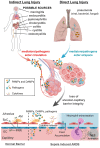Integrating molecular pathogenesis and clinical translation in sepsis-induced acute respiratory distress syndrome
- PMID: 30674720
- PMCID: PMC6413834
- DOI: 10.1172/jci.insight.124061
Integrating molecular pathogenesis and clinical translation in sepsis-induced acute respiratory distress syndrome
Abstract
Sepsis-induced acute respiratory distress syndrome (ARDS) has high morbidity and mortality and arises after lung infection or infection at extrapulmonary sites. An aberrant host response to infection leads to disruption of the pulmonary alveolar-capillary barrier, resulting in lung injury characterized by hypoxemia, inflammation, and noncardiogenic pulmonary edema. Despite increased understanding of the molecular biology underlying sepsis-induced ARDS, there are no targeted pharmacologic therapies for this devastating condition. Here, we review the molecular underpinnings of sepsis-induced ARDS with a focus on relevant clinical and translational studies that point toward novel therapeutic strategies.
Conflict of interest statement
Figures

References
-
- Vincent JL, et al. The SOFA (Sepsis-related Organ Failure Assessment) score to describe organ dysfunction/failure. On behalf of the Working Group on Sepsis-Related Problems of the European Society of Intensive Care Medicine. Intensive Care Med. 1996;22(7):707–710. doi: 10.1007/BF01709751. - DOI - PubMed
-
- Churpek MM, et al. Quick Sepsis-related Organ Failure Assessment, Systemic Inflammatory Response Syndrome, and Early Warning Scores for Detecting Clinical Deterioration in Infected Patients outside the Intensive Care Unit. Am J Respir Crit Care Med. 2017;195(7):906–911. doi: 10.1164/rccm.201604-0854OC. - DOI - PMC - PubMed
Publication types
Grants and funding
LinkOut - more resources
Full Text Sources
Medical

